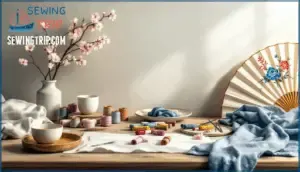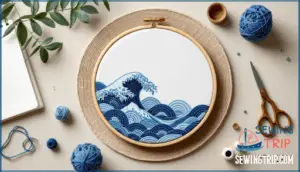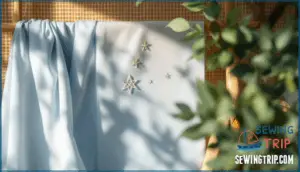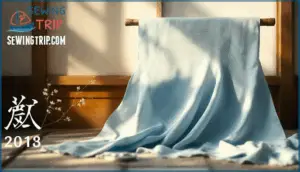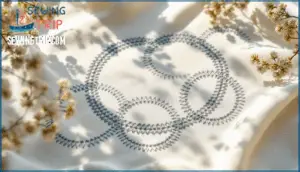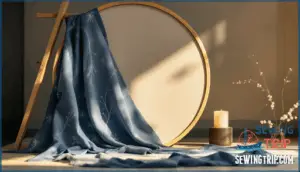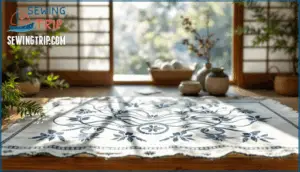This site is supported by our readers. We may earn a commission, at no cost to you, if you purchase through links.
 When Japanese peasants living under the Tokugawa shogunate needed to stretch a single garment through multiple winters, they reached for needle and thread. What began as desperate mending in the 1600s—layering running stitches to patch worn fabric—evolved into something far more extraordinary.
When Japanese peasants living under the Tokugawa shogunate needed to stretch a single garment through multiple winters, they reached for needle and thread. What began as desperate mending in the 1600s—layering running stitches to patch worn fabric—evolved into something far more extraordinary.
Those utilitarian rows of white thread on indigo cloth weren’t just repairs; they became a visual language, with geometric patterns encoding wishes for protection, prosperity, and longevity. Traditional Japanese sashiko stitching patterns carry centuries of ingenuity born from scarcity, shaped by strict sumptuary laws that banned peasants from wearing silk or bright colors.
Today, these same patterns offer modern crafters a direct link to resourceful ancestors who transformed necessity into an enduring folk art.
Table Of Contents
Key Takeaways
- Sashiko emerged in 17th-century Japan as practical mending among peasants forbidden by sumptuary laws from wearing silk or bright colors, transforming necessity into a folk art tradition where geometric patterns encoded wishes for protection and prosperity.
- The craft centers on a simple running stitch executed with specific precision—stitches measuring 2-7mm with gaps one-third the stitch length, using thick cotton thread on plain-weave fabric to create both decorative and reinforcing effects.
- Traditional patterns like asanoha (hemp leaf), seigaiha (blue wave), shippo tsunagi (seven treasures), and kikkō (tortoiseshell) each carried symbolic meanings tied to children’s growth, resilience, prosperity, and longevity within Japanese culture.
- Nearly extinct by the 1970s due to mass production, sashiko experienced a global revival in the 1980s through sustainability movements, now blending traditional techniques with contemporary fashion while honoring its roots in resourcefulness and repair culture.
Sashiko’s Historical Roots in Japan
Sashiko didn’t start as art—it came from necessity. Rural Japanese communities in the seventeenth and eighteenth centuries couldn’t afford to waste cloth, so they turned scraps into something stronger and warmer through simple stitching.
Sashiko was born from necessity—rural Japanese communities stitched scraps together to make clothing stronger and warmer when cloth was too precious to waste
Understanding where sashiko began helps explain why its patterns and techniques still matter today.
Origins Among Rural Communities
Rural Sashiko emerged from necessity in Japan’s farming and fishing villages during the Edo period (1603–1868). You’ll find its roots in the hardships of northeastern regions, where harsh winters and scarce resources pushed families to reinforce hemp and bast fiber garments with simple running stitches.
This Japanese folk art tradition transformed practical mending into village crafts rich with Japanese heritage, as mothers taught daughters traditional embroidery techniques that kept clothing functional across generations. This Japanese stitching method embodied resourcefulness long before cotton became available. The traditional technique is characterized by its use of Japanese embroidery methods to create durable garments.
Influence of Edo-Era Sumptuary Laws
Sumptuary laws shaped Sashiko as we recognize it today. Between 1600 and 1867, the Tokugawa shogunate issued over 200 proclamations controlling what Japanese people could wear based on social hierarchy. These Edo Era restrictions dictated everything from fabric choice to decorative patterns, forcing commoners to work within narrow boundaries:
- Silk remained banned for lower classes, leaving only hemp, linen, and eventually cotton as permitted materials
- Bright colors like purple and beni-red were reserved for nobility, pushing peasants toward indigo and white
- Decorative stitching couldn’t exceed the size of a rice grain under official regulations
This Cultural Conformity paradoxically sparked creativity. When your options narrow to indigo cotton and simple white thread, you make something beautiful anyway—that’s how Sashiko’s distinctive aesthetic was born from legal constraint. The traditional Japanese craft techniques played a significant role in shaping the unique style of Sashiko.
Sashiko’s Evolution and Modern Revival
By the twentieth century, those legal restrictions had vanished, and ironically, so had most of the stitching traditions they’d inadvertently preserved. Mass production replaced hand-mending, pushing Sashiko stitching toward extinction.
The craft’s modern revival began in the 1980s when Japanese embroidery techniques caught global attention through sustainability movements.
Today’s Sashiko Revival blends traditional Japanese culture with Contemporary Designs, as Artisan Communities worldwide practice cultural heritage preservation while adapting this history of sashiko for Modern Applications.
Essential Sashiko Tools and Materials
Getting started with sashiko doesn’t require a trip to a specialty shop, but knowing which tools actually matter will save you time and frustration.
The basics are straightforward—fabric, thread, needles, and a way to mark your patterns—but each one plays a specific role in how your stitching turns out.
Let’s break down what you need and why it matters for traditional sashiko work.
Choosing The Right Fabric and Thread
When you’re starting a sashiko project, the foundation matters more than you might think—choosing your fabric and thread isn’t just about what looks good, but what will last stitch after stitch.
Traditional cotton fabric works best, particularly plain-weave varieties that let your needle glide through smoothly. Sashiko thread is thicker than regular embroidery floss and comes in natural or indigo-dyed options.
Linen fabric also lasts well for fabric mending and repair, though cotton choices remain the historical standard for authentic Sashiko stitching supplies.
Sashiko Needles and Cutting Scissors
A long, flexible needle is your steady companion in sashiko work—designed specifically to gather multiple stitches at once before pulling the thread through. You’ll want sashiko needles that measure around 2 inches long for efficient thread management and stitch optimization.
Sharp embroidery scissors manage fabric preparation and trimming with precision—proper scissor maintenance keeps your cuts clean and your sashiko stitching techniques flowing smoothly through each sashiko pattern.
Marking Tools for Pattern Transfer
Transferring your chosen pattern onto fabric calls for marking tools that disappear after stitching—or blend seamlessly into the finished piece. Fabric chalk and pattern markers lift away with light brushing, while iron transfer methods work beautifully for intricate geometric pattern design.
Tracing templates paired with stencil methods give you precision for repeated sashiko patterns—essential when your embroidery techniques demand accuracy across continuous lines in traditional sashiko stitching.
Defining Traditional Sashiko Stitching
If you’ve ever wondered what makes sashiko instantly recognizable, it comes down to the stitch itself. The running stitch forms the heart of this traditional craft, but getting it right takes understanding a few key principles.
Let’s look at what defines authentic sashiko stitching and how you can achieve those signature results.
The Ideal Running Stitch Technique
The running stitch might look simple—just a needle moving in and out of fabric—but in sashiko, it’s the foundation that turns plain cloth into something both beautiful and enduring.
You’ll weave the needle through multiple layers at once, keeping even stitch length and consistent spacing throughout. Thread tension control prevents puckering, while securing thread ends with small loops on the reverse guarantees your sashiko stitching techniques last over time.
Stitch Size, Spacing, and Thread Quality
You’ll want to think of sashiko stitch size and spacing like a rhythm—getting it right makes all the difference between embroidery that lasts and stitching that falls apart. Traditional sashiko stitches measure 2–7 mm on top, with gaps about one-third the stitch length, creating that signature look while reinforcing fabric.
Here’s what matters most:
- Stitch Length: Keep visible stitches no bigger than a grain of rice for proper reinforcement.
- Stitch Consistency: Aim for 2–3 stitches per centimeter along straight running stitch lines.
- Thread Tension: Use moderate, even tension to prevent puckering while maintaining fabric integrity.
- Sashiko Thread Quality: Choose 100% cotton, tightly-twisted thread (4- or 6-ply) that resists fraying.
Quality thread—with its matte finish and non-divisible construction—grips fabric layers without slipping, which is essential when you’re weaving through multiple cloth layers. Matching your stitch size to fabric weight guarantees your sashiko techniques create durable repairs that actually last over time.
Tips for Consistent and Durable Stitches
Mastering sashiko isn’t just about following the rules—it’s about developing muscle memory that turns careful technique into second nature.
Start by pre-washing fabric to prevent puckering later, and keep your stitch tension relaxed—you’re aiming for embroidery that lies flat, not fabric that bunches. Thread selection matters: quality sashiko thread won’t split mid-stitch.
Practice your needle technique by loading multiple stitches before pulling through, which creates the rhythm essential for stitch consistency in traditional running stitch work.
Iconic Sashiko Stitching Patterns
Sashiko’s visual language comes alive through its geometric patterns, each one carrying centuries of meaning and technical precision. These designs weren’t just decorative—they served as a vocabulary of symbols that communicated values, aspirations, and regional identity across Japan’s working communities.
Let’s look at four patterns that have become touchstones of the sashiko tradition.
Asanoha (Hemp Leaf) Pattern
If you’ve ever watched a hemp plant grow, you’ll recognize why the asanoha pattern—with its six-pointed stars radiating outward like leaves—became a symbol of hope that children would thrive with the same vigor.
This geometric design dominated children’s garments throughout the Edo period, its repeating six-pointed structure representing growth and good health. You’ll find stitch variations that emphasize different aspects of the pattern, but the cultural significance remains constant across Japanese folk art traditions—asanoha embodies the resilience families wished upon their young ones.
Seigaiha (Blue Wave) Pattern
While hemp leaves spoke to aspirations planted in youth, the seigaiha pattern—those endlessly layering concentric arcs—captured something more fluid: the rhythm of water itself, borrowed from the costumes of traditional gagaku court musicians who danced like waves rolling toward shore. You’ll recognize this wave motif on summer garments and family crests, where ocean inspiration meets Japanese heritage.
The geometric patterns create visual movement through stitch variations that honor Japanese folk art traditions, with each arc reinforcing seigaiha’s cultural significance as a symbol of resilience and endless possibility.
What seigaiha means for your practice:
- Each arc represents waves that never stop—persistence through life’s changes
- Summer clothing bore this pattern to invoke cooling water during humid months
- Family crests adopted seigaiha to symbolize prosperity flowing across generations
- Your stitching rhythm naturally mimics the pattern’s gentle, repetitive motion
- The design connects you to centuries of coastal communities who stitched by lamplight
Shippo Tsunagi (Seven Treasures) Pattern
Where water’s persistence spoke through waves, shippo tsunagi—the Seven Treasures pattern—weaves interlocking circles into a meditation on connection itself. Each ring touches precisely four neighbors to create harmony that Buddhist tradition holds as sacred.
You’ll find these geometric patterns on formal wear and ceremonial textiles, where their symbolic meanings represent endless fortune and human bonds that strengthen through shared boundaries.
The stitch variations in this sashiko design require patience—your needle follows curves that echo traditional Japanese crafts, transforming simple embroidery patterns into artistic expressions of unity’s cultural significance.
Kikkō (Tortoiseshell) and Linked Plovers Patterns
Beyond circles that bind fortune together, nature’s creatures earned their place in the stitcher’s vocabulary—kikkō hexagons borrowed from tortoiseshell geometry promised longevity, while linked plovers captured the playful tumble of shorebirds in stylized formation. These stitching patterns reflect cultural significance rooted in traditional Japanese crafts.
- Pattern symbolism connects natural forms to human aspirations for long life and strength
- Stitch variations transform geometric patterns into recognizable creatures through repetition
- Fabric choices determine how embroidery reveals design inspiration across garments
Symbolism and Cultural Significance
Sashiko patterns aren’t just about aesthetics—each design carries layers of meaning rooted in Japanese culture and everyday life. You’ll find that these stitches tell stories about family, nature, and the values that shaped rural communities during the Edo period.
Let’s look at what these patterns represent, how sashiko fits into Japan’s folk art tradition, and why this centuries-old craft matters in today’s world of sustainable making.
Meanings Behind Common Patterns
Each sashiko pattern carries deep cultural significance, functioning as stitched emblems that connected Japanese communities to shared hopes and beliefs. Asanoha’s geometric patterns symbolized children’s growth and protection, while seigaiha waves represented enduring peace across generations. The shippo tsunagi design invoked prosperity through its interlocking circles, and kikkō hexagons channeled the tortoise’s legendary longevity.
These traditional motifs weren’t mere decoration—they transformed humble fabrics into carriers of folk art heritage, weaving together stitching patterns with the spiritual fabric of Japanese culture itself.
Sashiko as Folk Art and Heritage
During Japan’s Edo era, you could gauge someone’s social standing just by looking at their stitched garments. Sashiko transitioned from working-class necessity to celebrated folk art through the Mingei influence, which elevated everyday crafts into cultural heritage worth preserving. Regional variations emerged across prefectures, with families passing down heirloom transmission techniques through generations—mothers teaching daughters patterns that doubled as marriageability markers.
Economic shifts in the twentieth century nearly erased this traditional craft:
- Mass production replaced repair culture
- Artisan numbers dwindled drastically by the 1970s
- Handwoven sashiko fabrics became rare luxury items
- Modern adaptations now blend Japanese culture with contemporary design
Today’s revival honors sashiko’s roots while embracing new expressions.
The Role of Sashiko in Sustainable Crafting
Your grandparents’ darned socks weren’t just frugal—they were practicing sustainability centuries before the term became a buzzword. Sashiko embodies zero waste embroidery through repurposed materials and mindful stitching practices that extend garment lifespans.
Modern makers are rediscovering these sustainable textile practices, transforming worn denim and frayed linens into eco-friendly textiles. This mindful crafting approach challenges fast fashion by celebrating repair over replacement—traditional crafts meeting contemporary environmental consciousness.
Frequently Asked Questions (FAQs)
What are the traditional Japanese sashiko patterns?
Traditional geometric patterns like asanoha (hemp leaf) and seigaiha (blue wave) dominate Japanese embroidery.
These Sashiko patterns use running stitch variations on indigo fabric, blending cultural inspirations with practical fabric choices in traditional crafts.
What is traditional sashiko stitching?
Picture a needle weaving resilience into worn fabric—that’s Sashiko stitching. This traditional Japanese embroidery uses simple running stitches to create geometric patterns.
Originally, it strengthened clothing for rural communities during the Edo period, transforming necessity into art.
What is the most commonly used stitch in sashiko?
The running stitch defines Sashiko stitching—you’ll use it for every pattern. This simple technique involves even stitch length, consistent thread tension, and proper fabric choice.
Sashiko technique transforms basic embroidery into meditative art, perfect for beginners exploring traditional Sashiko patterns.
What is the name of the pattern in sashiko?
Like threads mapping constellations across fabric, each sashiko design carries a name and story. Asanoha (hemp leaf), Seigaiha (blue wave), and Kikkō (tortoiseshell) represent the most iconic geometric patterns in Japanese embroidery.
These Sashiko symbols transform basic Sashiko stitching for beginners into meaningful art, with regional variations like Hida Sashiko creating distinct motifs.
What are the best fabrics for Sashiko stitching projects?
Cotton choices work best—think homespun or tightly woven linen.
Fabric weights matter: medium-weight natural fibers like indigo-dyed cotton secure stitches beautifully.
Thread counts and weave types affect how your needle glides through the textile art.
How do I transfer Sashiko patterns onto fabric accurately?
Most stitchers rely on three methods: washable fabric marking pens for light-colored cotton, transfer paper with a tracing wheel for darker textiles, or templates with a chalk pencil. Accuracy improves when you secure your fabric flat before marking.
What are the differences between Sashiko and Boro stitching?
While sashiko refers to decorative embroidery using running stitches in geometric patterns, boro techniques involve layering patched fabric scraps with functional mending stitches.
Sashiko emphasizes traditional Japanese culture through symbolic designs; boro prioritizes practical fabric repair and weaving together worn textiles for extended use.
Can I use Sashiko stitching for modern fashion designs?
Absolutely—contemporary embroidery thrives when modern sashiko meets fashion trends.
Designers worldwide incorporate this Japanese textile art and craft into sustainable fashion, from denim jackets to runway pieces, blending traditional techniques with Japanese chic aesthetics.
How do I care for and maintain Sashiko-stitched garments?
Hand washing in cool water protects both fabric and thread from shrinkage.
Air-dry your sashiko pieces flat to maintain stitch tension.
For ironing, press gently on the reverse side to preserve the textile art’s dimensional quality and prevent shine on the stitching.
How do you start and end sashiko thread?
Secure Sashiko thread without knots by weaving your needle back through previous stitches on the fabric’s wrong side, creating a small loop.
For finishing, run the thread through completed stitching, maintaining proper thread tension throughout your needlework.
Conclusion
Like tracing your grandmother’s handwriting in an old letter, learning traditional Japanese sashiko stitching patterns connects you to centuries of makers who refused to let scarcity erase beauty. Each running stitch you place—whether asanoha’s radiating points or seigaiha’s rolling curves—carries forward the same resourceful spirit that transformed mending into art.
You’re not just practicing a technique; you’re joining a lineage of hands that proved limitation sparks creativity, turning necessity into something worth preserving.

